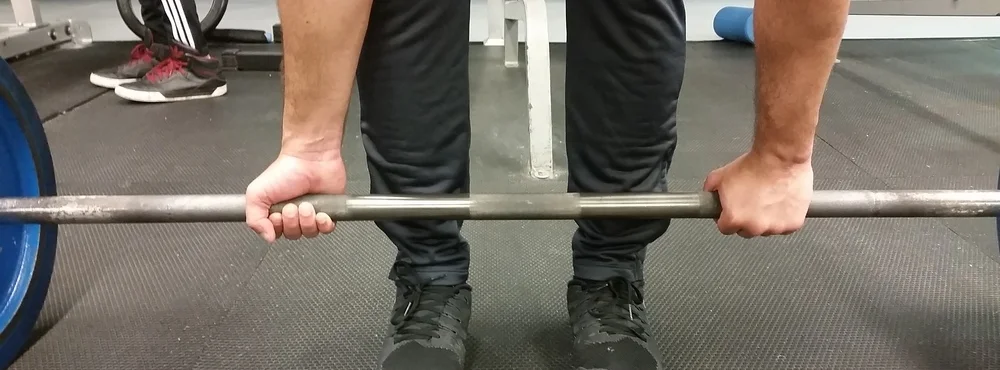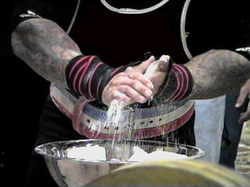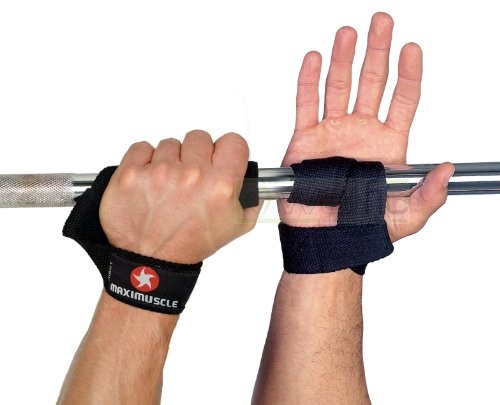Deadlift Deconstruction Part 2: Grip it and rip it.
Grip Strength - The most commonly overlooked aspect of the deadlift.
You're beginning to love the deadlift. You've got your form on point. Your spine is neutral, your posterior chain is loaded, the bar is flying off the ground and you're locking it out strong. Every session you're adding weight to the bar. This is the dream. You're unstoppable. Then one day the bar moves 2 inches of the ground, your fingers unravel, and gravity steals the weight back to the floor while catapulting your body back into a standing position. What the hell. You've gone from hero to zero in a single session.
Next session, you try again, knowing what happened lat time. This time you manage to hold onto the bar, but because its moving so much slower off the ground than previously, you're pulled forwards, your hips shoot up, and its pure will power that you lock it out. You quickly drop back to your starting position and think "that barely made it up, and I almost snapped myself up. How am I supposed to do 4 more reps?"
It is a bitter sweet moment when you become stronger than your own hands. But fear not, your lifting journey of strength gains has not come to an end, its just time to tweak a few things.
There's no such thing as a strong deadlift with a weak grip.
Or any pull exercise for that matter. In regards to the first speed bump in deadlift progression for beginners, their grip is going to give up.
Your body uses your grip as a "fail safe mechanism". If you are gripping onto something heavy that you may not be able to maintain holding onto, something very interesting happens. Your brain takes note and reduces motor recruitment through your nervous system. Basically it won't let the rest of your muscles "turn on" to prevent you from attempting to lift something that could injure you. It is the first port of call for your nervous system to decide if you're going to move the weight. Fascinating on a physiological level, highly frustrating on a training level. Especially when your Legs and back are more than willing to do the hard work.
If you are on the cusp of having the strength to lift the weight, the example in the second paragraph of this blog will happen to you. Your bar speed will slow down as you spend so much of your nervous system's precious resources on keeping your hands clasped to the bar. The slowdown in speed will flair up every weak point in your lift as you try to overcompensate for bar speed using other means. Such as lifting with your spine. Never lift with your spine. EVER. (I know you're not lifting with your spine but you get the idea).
Maximise grip by choosing the right type for you
There are a few different ways to hold onto a barbell for pull movements.
1. Double overhand
As a beginner odds are you have started deadlifting with your hands in this position. It is what feels most natural, it promotes symmetry and therefore is the easiest way to learn to pull and drill in great technique. The downside? It is also the hardest way to hold onto a barbell. You are set up to fail trying to stick with this grip. While I believe it is the perfect starter, it has a relatively short shelf life if you're wanting to move heavier weights. My advice is: stick with it as long as you can to ensure you're mastering perfect form.
The reason it begins to fail is because he bar will eventually want to roll out of your fingers as it essentially is reliant on only your thumbs holding onto it.
2. Mixed Grip
The vast majority of people are going to end up deadlifting like this given enough time. It may seem weird to begin with but you'll quickly find that once you get used to your hands being asymmetric, your ability to hold onto heavy things explodes exponentially. This is because you are essentially removing the main weak point of the double overhand grip. By having an alternating hard placement, there is no obvious weak point for the bar to roll to and slip out of your grip.
I don't recommend doing the mix grip straight away, only switching to it once you've milked your double overhand grip as much as possible. This is because with a mixed grip the alternating hands can cause you to rotate as you pull. It is important to learn to feel what a symmetrical pull feels like first with the double overhand, shoulders feet and hips all in alignment, so you don't fall into this trap.
Another downside with the mixed grip is its asymmetric nature can lead to muscular imbalances. This could be avoided by alternating which way round your hands are between sets, but trust me, one way is going to feel far more comfortable than the other. So you'll always default to a specific alternation for your heavy pulls and therefore always end up performing more volume with one grip position. This can lead to most notably one trap bigger than the other and one lat bigger than the other, due to the different stabilising of the shoulder depending which way round your hands are. Finally you are at a higher risk of tearing a bicep with your supinated hand (reversed hand), and that is not fun in the least bit. All this risks are manageable, but it its still worth noting there is long term risk in pulling with a mixed grip.
3. Hook Grip (Recommended)
If you learn to hook grip heavy deadlifts, other lifters will look at you like some sort of magical unicorn that is impervious to pain. Hook grip sucks to get used to. It hurts your thumbs and you're going to complain about it. But it does get better, and although it might seem impossible at first, just remind yourself that it is the ONLY grip Olympic Weightlifters use and they commonly snatch your max deadlift above their heads. Once mastered you'll have very few gripping issues for the rest of your life. I wish more casual lifters skipped the mixed grip and went straight from the double overhand grip to the hook grip. You'll avoid injuries through muscular imbalances, as well as having little adjustment in regards to your form because it will be identical to your double overhand form. If you learn it from the start, you won't be like me, and be deadlifting in the 500lbs before having to go back down significantly in weight to learn to grip all over again. I am biased in regards to the hook grip because I was injured from over use of a mixed grip, so keep that in mind.
A little bit of help?
Chalk
Believe it or not, chalk doesn't exist as something to film yourself clapping before a lift solely to get a cool slo mo shot for the beginning of your instagram video. Chalking up your hands will do a few things. It will absorb moisture/sweat from your palms. It also compresses under tension, ultimately gripping onto itself, and increasing friction between your hand and the bar. This decreases the bars ability to roll in your hands.
Chalk should be applied to your hands and NOT DIRECTLY onto the bar, as all this ends up doing it filling in the knurling and causing the bar to be smoother.
While using chalk may be the difference between getting a lift or a barbell slipping out of your hand, it is no substitute for a weak grip.
Straps
The quickest way to have people on instagram claiming that your lift doesn't count because you used straps. This works by offsetting some of the weight from hour palms to around your wrists. If the bar begins to slip, the straps tighten around your wrists.
Do I consider straps cheating though? Not really, especially for recreational lifters (you can't compete in powerlifting with straps). But they can mask a bigger problem because they are so effective. I personally think straps should be kept for higher rep work. Not because you can't grip it, but more to spare the flesh on your palms. Sure you'll callus up and the skin on your palms thicken over time, but if you are feeling that a high volume pull workout is going to begin to rip the skin on your palms, then strap up. Bleeding hands may look manly as hell, but they also will hinder future training sessions till they heal.
I personally feel that you should be able to pull your heaviest single WITHOUT straps. Chalk is fine, but learn to do it without the straps. Remember that "fail safe" your nervous system has I mentioned at the beginning of this post? Yeah well, you're over riding that. By making sure you can pull without straps and rely on your grip instead, you are also making sure that your tendon, ligaments, and muscles are capable of working at that intensity.
Gym Gloves
Don't wear them. Just don't. And I'm not saying this from a "it isn't manly" point of view. If you're wearing gloves because lifting weights hurts your hands, thats normal. Let your hands become conditioned to it and within a few weeks you won't even think about it.
Gloves prevent this process from happening.
Secondly, gloves can make gripping weights EVEN HARDER. Firstly, by having padding between your hand and the bar means the circumference you are gripping has increased. Any strong man can tell you that pulls with thick bars are far more difficult. Secondly, while the rubber on the glove may create a lot of friction and not slip off the bar, all that ends up happening is your palms slip and don't grip to anything inside of the glove. So rather than now having to worry about 2 surfaces having enough friction between them to grip the bar (your hand and the barbell), you now have 3. You've created a grip sandwich. Your gloves have become the awkward 3rd wheel on your date with a barbell.
But how do I increase my grip strength?
All will be revealed in time. Now that you understand grip as a starting point in your deadlifts and pulls, begin applying it. The next blog I write on the "Deadlift Deconstructed" series will go over specific exercises to help increase grip strength, so make sure you subscribe to my blog to keep posted!
Grab my new eBook "Triple Threat". Use the code "FirstIn" at checkout for a discount!
A gruelling 12 week programme designed to get you jacked and strong. Over 50 pages of information, 10 additional training templates, and all this periodised to get you squatting, benching, and deadlifting more than you thought possible.






